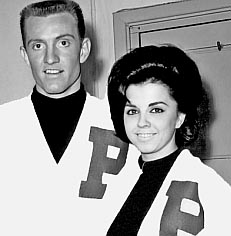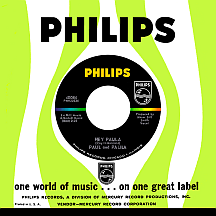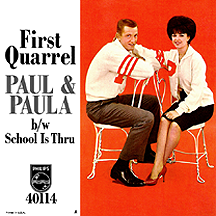PAUL AND PAULA
Hey Paula
While attending Howard Payne University in Brownwood, Texas in 1962, 21-year-old Ray Hildebrand composed songs, played guitar and sang locally with a group called The Prisoners. His friend Russell asked him to write a song for his girlfriend, whose name was Paula; Ray agreed to do it but had difficulty with the lyrics. Another friend suggested he write it as a duet, a guy singing to his girl followed by a response from her. Good idea, but "Russell and Paula" didn't go together very well, at least as song lyrics. He was reminded of Annette's three-year-old hit "Tall Paul" and the song started coming together ('Hey hey Paula, I wanna marry you' - 'Hey Paul, I've been waiting for you...'). While the ditty didn't thrill his friend, who would have preferred to have his own name used, it nevertheless impressed Paula and the two ended up getting married. As for the "Paul and Paula" of Hildebrand's lyrics, well...they were never meant to be anything more than just characters in a song!
A friend of Ray's from school, 20-year-old Jill Jackson, had her own musical aspirations and began singing with Ray; they performed a few times on a local radio station, KEAN, and a live rendition of Ray's throwaway "Hey Paula" song suddenly had everyone in the college town abuzz. In October '62, Ray and Jill headed to the nearest place available for recording, the Clifford Herring Studio in Fort Worth. Unexpected and unannounced, the duo nevertheless squeezed in a quick session when a scheduled singer didn't show. They recorded Ray's song and another Jill had written, "Bobby is the One," with producer Major Bill Smith (who'd hit the jackpot the previous year with "Hey! Baby" by West Texan Bruce Channel). Smith released it on his own Le Cam label by Jill & Ray, probably less confusing than if it had been credited to Russell and Paula, though it would have seemed odd either way. "Hey Paula" blew up in Brownwood and within a few weeks it had taken over Dallas radio, hitting number one in December at each of the city's competing top 40 stations, KBOX and KLIF.
Major Bill sold the rights to the master, and Jill and Ray's contract, to Mercury Records; released on the Philips label, their names were dumped in favor of the more logically marketable Paul and Paula, despite its having already been a big hit in a major city under the duo's actual names. Jill and Ray were instructed to play up the song's message and act like sweethearts in real life. The song, all innocence and bliss with its subliminal chapel-organ backing arrangement, hit number one the second week in February 1963 and was one of the year's best-selling singles; before they knew what had hit them, Dick Clark presented the pair with a gold plaque for sales of a million copies. The "youthful romance" angle was played to the hilt, straightforwardly and without apologies; "Young Lovers," also penned by Hildebrand, came on the heels of the breakthrough smash and spent the entire month of April in the national top ten.
They proceeded with songs that played like a real-life story. In "First Quarrel," penned by Major Bill with "Hello Trouble" country singer Orville Couch and his pal Eddie McDuff, jealousy reared its ugly head ('I thought I saw you with Jim' - 'I was just talking to him!') and sent them back to the top 30 in June. "Something Old, Something New" (you know what the next two "somethings" are), written by Smith's friend Marvin Montgomery (who'd penned a couple of Channel's singles) and Mary Tarver, suggested the "Quarrel" didn't derail the union between the vocal duo's fictional counterparts. Seasoned hitmakers Don Wolf and Ben Raleigh penned "Flipped Over You," giving the relationship a sweetly obsessive tone. "First Day Back at School" offered the neophyte Hildebrand-Jackson songwriting team's take on not letting marriage get in the way of finishing college. All of these singles made the charts, keeping Paul and Paula's presence a steady one throughout 1963.
A Christmas album was released and "Holiday Hootenanny," combining surf guitars and sleigh bells with summery lyrics set to the tune of "Jingle Bells," detoured significantly from previous works. It sold well during the '63 Christmas rush and helped conceal the fact that the duo had actually split up a month earlier! Ray, weary of his "Paul" charade and just plain burned out, disappeared in November during a tour of Dick Clark's Caravan of Stars, returned to his home in Joshua, Texas, reunited with his girlfriend, married her soon afterwards, and vowed to leave showbiz behind. Jill wasn't happy with the situation...but never fear! Dick Clark stepped in to save the day, performing as "Paul" for the remaining dates (wish I could have seen that)!

Two Paul and Paula singles were released on Philips in 1964 but didn't chart; while still under contract as "Paula," Jill Jackson began recording for Reprise Records. Four singles were released starting in the fall of '64, two of them produced by Dick and DeeDee, P&P's friendly rivals during their peak (one of D&D's own odes to romance, "Young and in Love," had hit the top 40 right in the midst of the first two Paul and Paula hits). While Jill's Reprise output fit the style of the girl singers of the period, she sounded frail in comparison to the bigger stars (Lesley Gore, Dusty Springfield, Brenda Lee and even minor '65 comeback cutie Connie Stevens). "Here Comes the Night" was probably her best shot (Van Morrison's group Them had the hit), but Jill's hopes were dashed when Reprise dropped her after a year with the label.
Ray had a change of heart and returned in mid-'64. Major Bill welcomed him and Paul and Paula were back in business...just not in person. Jill had moved to Los Angeles to follow her dreams of solo stardom but Ray chose to stay in Texas (a few years later, he and his wife moved to Kansas City). Paul and Paula's parts were recorded separately and no one was the wiser, most likely because so very few heard any of the music they made during the mid-'60s. Their weirdest single was "Dear Paula," a spoken word track with Paul reciting a letter to Paula followed by her answer while "Hey Paula" plays in the background. This might have been a good time for the duo to call it quits...but they didn't!
Ray made a couple of singles as, simply, Paul (one for Josie in '65 and another for Tower in '66) while also recording under his real name for Philips concurrent with the final few Paul and Paula 45s made for the label. Other P&P singles occasionally popped up; there was one on Uni in '68 and another on United Artists in '70. Solo Hildebrand efforts appeared on Metromedia, Myrrh and Smith's Le Cam label, still going in the 1970s. In the '80s, Ray teamed with Paul Land and they performed for many years as a Christian folk duo, Land and Hildebrand. As for the never-intimate but always-friendly relationship between Ray Hildebrand and Jill Jackson, they've gotten together on a number of occasions throughout the years to reminisce, perform "Hey Paula" and some of their other hits and play the part of America's Sweethearts all over again, even if it is, and always was, just an act. A convincing one, at that.



